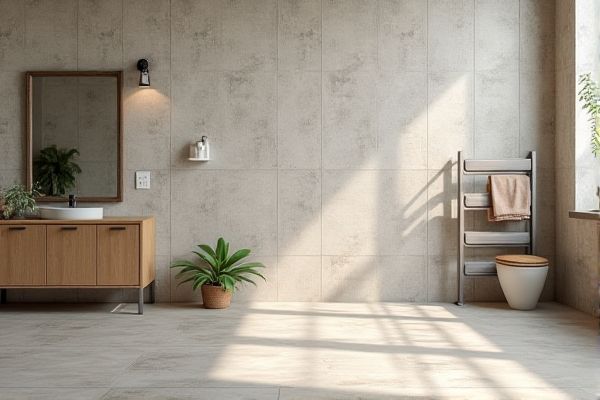
Textured tiles provide enhanced slip resistance and a tactile surface ideal for wet or high-traffic areas, while smooth tiles offer a sleek, easy-to-clean finish perfect for modern and minimalist spaces. Explore the rest of this article to discover which tile type best suits your needs and style preferences.
Table of Comparison
| Feature | Textured Tile | Smooth Tile |
|---|---|---|
| Surface | Raised or patterned for grip | Flat and even surface |
| Slip Resistance | High slip resistance, ideal for wet areas | Lower slip resistance, best for dry areas |
| Maintenance | More difficult to clean due to grooves | Easy to clean and maintain |
| Appearance | Rustic or natural look | Sleek and modern aesthetic |
| Use Cases | Bathrooms, outdoor patios, kitchens | Living rooms, walls, backsplashes |
| Cost | Generally higher due to texture and material | Usually lower, wide variety of options |
Introduction to Textured and Smooth Tiles
Textured tiles feature a non-uniform surface that enhances slip resistance, making them ideal for wet or high-traffic areas. Smooth tiles offer a sleek, polished look that reflects light and simplifies cleaning, commonly used in modern indoor spaces. Both tile types vary in materials such as ceramic, porcelain, and natural stone, affecting durability and aesthetic appeal.
Key Differences Between Textured and Smooth Tiles
Textured tiles feature a raised or patterned surface offering enhanced grip and slip resistance, making them ideal for wet areas like bathrooms and kitchens. Smooth tiles have a flat, polished finish that provides a sleek look but can be more slippery when wet. Key differences include safety applications, maintenance ease, and aesthetic versatility, with textured tiles requiring more effort to clean due to their uneven surfaces.
Aesthetic Appeal: Textured vs Smooth Tile Designs
Textured tiles offer a distinctive aesthetic appeal through their tactile surfaces and intricate patterns, creating depth and visual interest ideal for accent walls or flooring with character. Smooth tiles provide a sleek, polished look with clean lines and reflective qualities that enhance a modern, minimalist design. Your choice between textured and smooth tile designs impacts the overall ambiance, balancing between bold, dynamic aesthetics and elegant simplicity.
Slip Resistance and Safety Considerations
Textured tiles provide enhanced slip resistance due to their uneven surface, making them ideal for high-traffic or wet areas where safety is a priority. Smooth tiles, while easier to clean, tend to be more slippery when wet, increasing the risk of falls and requiring additional safety measures such as anti-slip coatings or mats. Selecting textured tiles can significantly improve safety in environments like bathrooms, kitchens, and outdoor spaces by reducing slip hazards.
Maintenance and Cleaning: Which is Easier?
Smooth tiles offer easier maintenance and cleaning due to their flat surface, which prevents dirt and grime from accumulating in crevices, allowing for quick wiping and mopping. Textured tiles require more effort to clean as their uneven surfaces trap dust and debris, necessitating scrubbing and specialized tools to maintain their appearance. Choosing smooth tiles enhances long-term cleanliness efficiency, especially in high-traffic areas prone to frequent dirt buildup.
Durability and Longevity Comparison
Textured tiles generally offer enhanced durability due to their raised patterns, which resist scratches and wear better than smooth tiles, making them ideal for high-traffic areas. Smooth tiles, while often easier to clean and maintain, may show signs of wear and surface damage more quickly under heavy use. Your choice between textured and smooth tile should balance the desired aesthetic with the specific durability requirements of the installation space.
Best Applications for Textured Tiles
Textured tiles are ideal for areas prone to moisture or heavy foot traffic, such as bathrooms, kitchens, and outdoor spaces, due to their enhanced slip resistance. Their surface provides superior grip compared to smooth tiles, making them a safer option for wet or slippery environments. Choosing textured tiles for your flooring or walls can improve safety while adding a tactile, visually interesting dimension to the space.
Ideal Uses for Smooth Tiles
Smooth tiles are ideal for indoor applications such as kitchens, bathrooms, and living areas where easy cleaning and maintenance are priorities. Their flat surface enhances light reflection, making spaces appear brighter and more spacious. Smooth tiles also provide a sleek, modern aesthetic suitable for contemporary interior designs.
Cost Comparison: Textured vs Smooth Tiles
Textured tiles often come with a higher price tag due to their intricate designs and manufacturing processes, while smooth tiles generally cost less because of simpler production methods. Installation costs for textured tiles may also be higher as they require more careful handling and precise placement to maintain their pattern and grip. Your budget should consider both the material and labor expenses when choosing between textured and smooth tiles for a cost-effective flooring solution.
Choosing the Right Tile for Your Space
Textured tiles provide enhanced slip resistance and a tactile surface ideal for high-traffic or wet areas, making them perfect for bathrooms and outdoor spaces. Smooth tiles offer a sleek, polished look that enhances light reflection and ease of cleaning, suitable for kitchens and living rooms. Selecting between textured and smooth tiles depends on safety needs, aesthetic preferences, and maintenance requirements for your specific interior or exterior environment.
 homyna.com
homyna.com